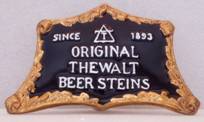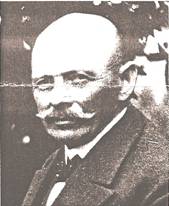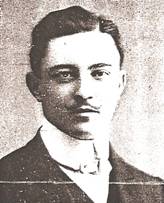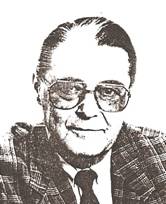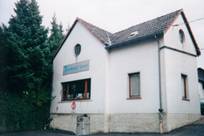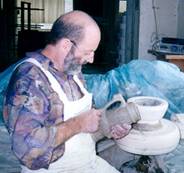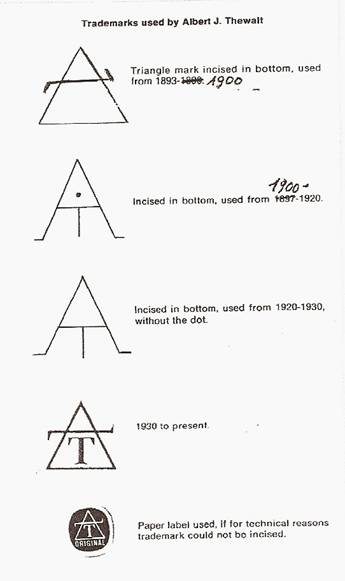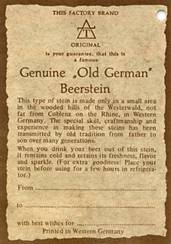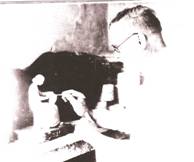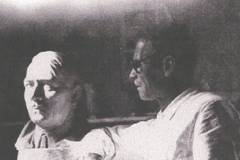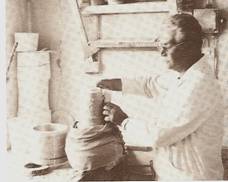Section I
|
|
Introduction
Whenever you declare something as the best, biggest or
oldest, you still need to further define what you are measuring to fend off
competing claims. The subject of my title, Albert Jacob Thewalt, GmbH, has such
qualifiers in the title. Some may argue that the firm of Simon Peter Gerz is the
oldest. It was founded 31 years before Thewalt in 1862, although it was doing
business before that date. It has been quite a few years, however, since it was
in the Gerz family hands and fell on bad times when it finally went bankrupt in
1999. The name and logo were purchased by Domex and that firm reincorporated
Gerz and still sells steins under that name and logo although they are made in
When I decided that my topic would be on the Thewalt firm, I searched past issues of Prosit for articles on Thewalt. I was amazed at how so little has been written about this fine firm. The first article was by Liselotte Lopez discussing Thewalt’s production methods and featuring pages from old catalogs in the September 1974 issue of Prosit. This was a reprint of an article that first appeared in the November 1973 issue of Spinning Wheel. Jack Lowenstein had an article in the September 1980 issue of Prosit on what else but a comparison of the old and new Munich Child character steins (Jack collected Munich Child steins and dressed as the Munich Child at the SCI conventions) made by Thewalt. George Schamberger had an article on the three regimental steins made by Thewalt in the September 1984 issue of Prosit. Jack Lowenstein’s article in the June 1985 issue of Prosit announced a new venture for Thewalt with Mr. Armin Seng, great-grandson of Peter Dümler, to reproduce some limited edition salt-glazed steins designed by Peter Dümler, aptly named the Peter Dümler series. Roland Henschen wrote an article on the current production methods of the Thewalt firm in the June 1991 issue of Prosit. Mr. Henschen also wrote an article on the history of the Thewalt firm on the occasion of its 100th anniversary in the December 1993 issue of Prosit. John Gaustad wrote an article on the Paulus & Thewalt stein made by Thewalt for the 25th anniversary of his former firm in the June 1996 issue of Prosit. Frank Loevi had an article on the new pewter-banded steins by Thewalt in the June 1999 issue of Prosit. The Beer Stein Library has a reprint of the last article (no membership required to view it) along with the start of a catalog of the Thewalt beer steins (membership in The Beer Stein Library, not related to SCI, is required to view the stein catalogs on that site). Jerry Berg had an article on the multiple molds of Thewalt 1273, a modern stein, in the March 2004 issue of Prosit. Walt Vogdes wrote an article on the Paulus & Thewalt steins made by Thewalt in the December 2004 issue of Prosit. Barry Tousaint had an article on American souvenir steins made by Thewalt in the December 2007 issue of Prosit. Several relief souvenir steins are shown in full color and none of them are in the Thewalt catalog on The Beer Stein Library. And, of course, Sam Brainard immortalized the Thewalt firm in four poems (the Herring stein in June 1983, the Rich Man stein in March 1984, the Sailor stein in the December 1987 and the Munich Child stein in the June 2000 issues of Prosit). In the twelve Prosit articles on Thewalt, only a few etched steins from circa 1900 are shown, and none are in color. There may be other articles that include Thewalt steins (Photos from the Road and HR steins produced by other firms would be two examples), but I have not included them here. Considering that over 4,700 pages of Prosit have been published (while the September 2008 issue ends with page 2,472, numbering restarted in 1992 after the first 2,272 pages), that means less than one-half percent of the pages have been devoted to Thewalt steins. A listing of the articles can be found in references 1-15.
Hopefully this article will lead to more recognition of this firm for their fine etched stoneware and character beer steins and provide us with more photos of their now antique beer steins.
I started collecting beer steins about the time Stein Collectors International was founded, although I did not discover their existence until a couple of years later when an antique dealer directed me to SCI. I knew little about beer steins, only saw a limited number of beer steins and collected even fewer beer steins. I forget whether I bought what I liked or liked what I bought, but that was the start of my collecting experience, thanks to my wife and her sister who got me started in this fascinating hobby. I soon learned that most collectors specialized in certain categories of steins. I narrowed my choice to etched and character steins, although I still buy some others if I really like them. It took me a number of years to discover that Thewalt also made etched beer steins, but I am happy I did as I find them to be quite pleasing to the eye and quite worthy of collecting as you will soon see in the photographs I have of these steins. They also made a few character steins that are also worthy of consideration for your collection.
Thewalt History
The Thewalt family has a long line of potters tracing back
to the 1700s. Hermann Thewalt was
listed in the Pottery Guild in 1781. Hermann’s son Johann Peter Thewalt
(1784-1861), also a potter, moved from Hillscheid to Höhr where he married in
1813. His son, Johann Peter Thewalt, Jr.( 1822-1887), founded the firm of Johann
Peter Thewalt in 1852. One of his sons, Karl Thewalt (unk-1923) operated the
company until his death when his son Hubert kept it running until it closed in
1930. The other son of Johann Peter Thewalt, Jr., Albert Jacob Thewalt
(1857-1939) founded Paulus & Thewalt with his brother-in-law, Jean Paulus in
1882. Thewalt had married into the Gerz family and Paulus married Thewalt’s
sister. Albert left to start his own company in 1893 in Höhr. Roland Henschen
stated in his article in reference 7 that Albert Jacob Thewalt actually started
the firm 10 years earlier in 1883, but the current Herr Thewalt says that is
incorrect. In the past, there has
been confusion about the “TP” mark found on beer steins being that of Paulus
& Thewalt. It isn’t, although you still see attributions for that mark to
that firm. Paulus & Thewalt make stoneware products for the pharmaceutical
industry and still operates today. I contacted the firm and they confirmed that
they never produced beer steins. The “TP” mark is actually that of Johann
Peter Thewalt, Jr. See the article on the SCI web site in reference 15 for
further information on the “TP” mark. Albert Jacob Thewalt’s firm
initially was a cork cutting business. Perhaps that business was to make
closures for his former firm, however the business was short-lived as he also
began to produce products for the pharmaceutical industry. The Thewalt firm only
seriously got into steins in 1897 (there may have been some small steins made
prior to that date) when they hired Wilhelm Kamp to design beer steins. Albert’s son, Albert Johann Thewalt
(1884-1957) took over the firm on his father’s death. The grandson and current
operator, Albert Jakob Thewalt (1926-) returned home several months after the
end of World War II. He had been detained in an English internment camp and then
was transferred to an American prisoner of war camp, from which he fled in
December 1945. Since he had been reported as missing in action in the war, his
father was quite pleased to see that his son survived the war. Some articles
report that he returned from the war in 1950, but that is the date he completed
his education and returned to work at the Thewalt firm. He was a student at the
Photographs of the three Albert J. Thewalts (it was common to pass along the first names and/or initials to the first males in the family) can be seen on the next page.
|
|
|
|
|
Albert Jacob Thewalt about 1927 |
Albert Johann Thewalt about 1910 |
Albert Jakob Thewalt in 1993 |
A chart of the Thewalt family ties can be viewed by
clicking on the following link: http://www.steincollectors.org/library/articles/TP%20Mark/Thewalt_ties.htm.
This was part of an article on the SCI web site, but I do not think it is listed
in the Library at present. The page apparently remains in limbo on the web.
I state the firm was founded in Höhr in 1893, but today it is called Höhr-Grenzhausen as the cities of Höhr and Grenzhausen, along with Grenzau, merged to form the new city of Höhr-Grenzhausen in 1936. You will note the differences in the spelling of the middle name of the founder and the grandson, “c” for the former and “k” for the latter. There was an official change in the German spelling in the 1920s, although there was a transition period before and after that date. I mention this as a way to possibly date an object that contains one of those two items, but is otherwise not dated or cannot be dated by other means.
Thewalt did not continuously produce beer steins. The firm, along with other stein manufacturers, lost their export markets during and shortly after World War I and were forced to devote their production to the domestic needs of the country. Some of the firms did not survive the ravages of the wars and the tough economic times that followed. The occupation and reconstruction following WWII did provide a resurgence in the demand for souvenir beer steins. Finding a beer stein, other than one made for the military, during these periods will be difficult.
A few web sites still state that Thewalt employs 15 people and produces about 75,000 items per year. According to Herr Thewalt, as of September 2008 Thewalt has 9 employees and produces about 35,000 items per year. At the height of production in the 1960s, Thewalt employed 45 people with an annual production of about 250,000 wares.
Thewalt
Factory Tour
Shown below are a picture of the Thewalt factory and a picture of the stein making process from the Northcote Imports' web page in reference 16. If you have never toured a
|
|
|
|
Thewalt Factory |
Attaching a Handle to a Stein |
Manufacturer’s
Marks
The manufacturer’s marks are shown below with the approximate dates they were used,
|
|
|
|
|
c1970-1985 |
The Grenzau or Alt (Old) Grenzau mark was applied to modern
era steins made based on the old molds of Wilhelm Kamp and others. The 1894 date
on this mark refers to the date actual production started at Thewalt because the
firm was only registered in late 1893 and did not produce any wares in that
year. The building is an old castle overlooking Grenzau that features the only
triangular tower in
Some of Thewalt’s contemporary steins were made in limited editions. A certificate would normally be included with the stein, such as shown below:
|
|
|
Modelers
Wilhelm Anton Kamp (born in Höhr on
|
|
|
Wilhelm Kamp in his Studio |
Herr Thewalt provided the following insight about Thewalt’s chief designer. Herr Kamp
|
|
|
Wilhelm Kamp
with Hitler Bust circa 1935 |
Other than the SCI articles and references to being a
designer for Thewalt, the only reference to the work of Wilhelm Anton Kamp that
I could find on the Internet was that around 1900 he designed terra cotta
medallions of the child Jesus for the Parish Church of St. Peter and
Cesare Cardinale joined the Thewalt firm as a designer in 1971 and served in that
|
|
|
Cesare Cardinale |
